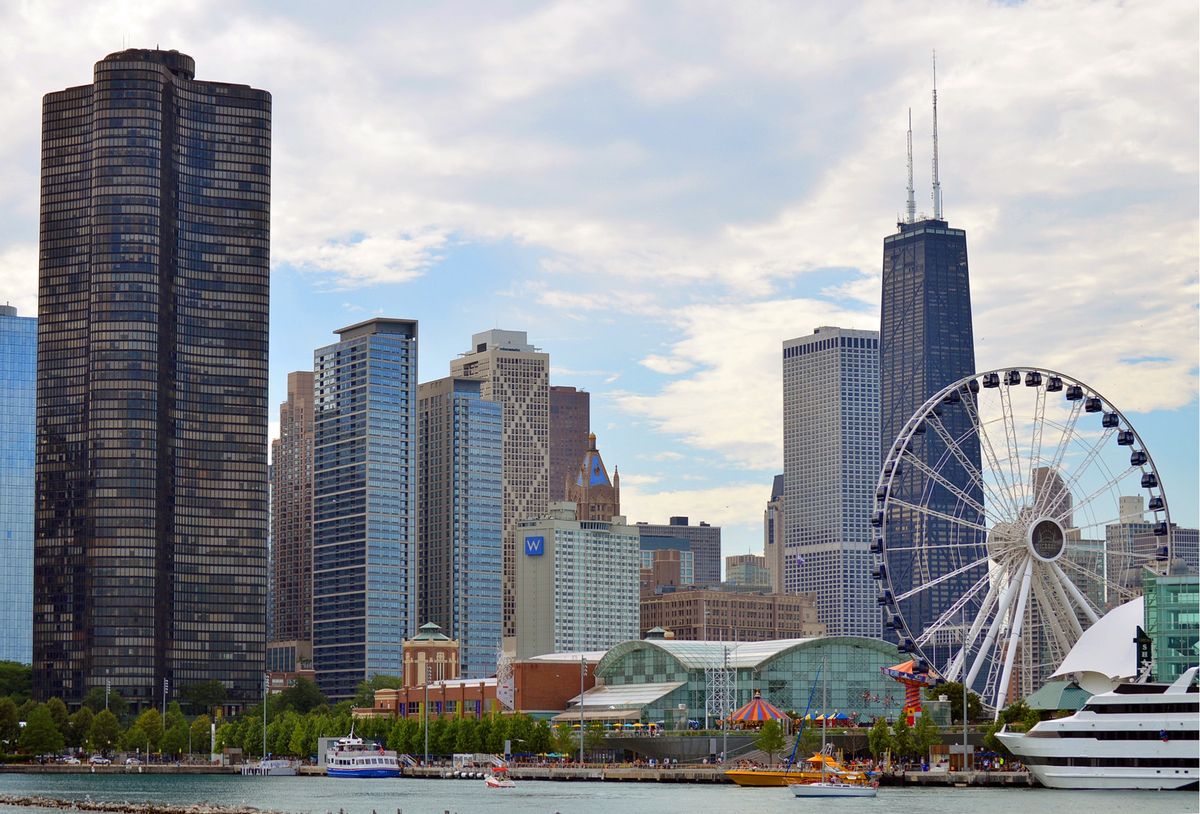The only thing hotter than the record temperatures across the Midwest the last couple of weeks is the region’s multifamily sector.
Rent growth in Chicago and other major central U.S. cities is sizzling, topping reports analyzing the metric in markets across the country.
And big multifamily and investment executives are making big plays, betting conditions are ripe for the asset class’s regional resurgence, despite macroeconomic headwinds hitting the sector at large.
“We’ve been the poor stepchild for a long time, and it seems now there’s some interest,” said Tim Anderson, CEO of Chicago-based developer Focus.
“Places where people flooded to [during the pandemic] have been overbuilt, and I think the demographics and the job growth in those areas will self-correct over time. But right now, Chicago looks pretty attractive.”

Chicago’s Navy Pier
Chicago saw 4.2% year-over-year rent growth in May, the third highest in the nation, behind Brookline, Massachusetts, and Hollywood, Florida, according to CoStar data. Other Midwest cities also far surpassed average national rent growth of 1% last month, with Indianapolis posting 2.6% growth and Madison, Wisconsin, hitting the 2.3% mark.
A growing number of capital sources are taking note and raising sizable funds to chase housing deals across the Midwest. Morgan Properties made a $500M Midwest multifamily bet in April, and Chicago-based Clear Investment Group is targeting $300M for a fund it launched in March aimed at workforce housing.
“The Sun Belt was obviously hot post-Covid,” Morgan Properties co-President Jonathan Morgan told The Wall Street Journal at the time. “At the moment, it’s the Midwest.”
Whereas multifamily investors once parked money in gateway cities like San Francisco, LA and New York as a means to preserve capital, places like Indianapolis, Minneapolis and Chicago have become strong draws for core and core-plus investments. That is thanks to organic growth and a wealth of homegrown offices, Trepp Senior Research Manager Tom Taylor said on last week’s edition of Bisnow’s First Draft Live.
In Chicago, first-quarter multifamily sales more than doubled compared to the same period in 2024, according to a report from Northmarq. Activity was evenly distributed across property classes, though Class-A prices shot up, with the median price rising to $421,500 per unit, up 33% from the 2022-2024 average.
From top-shelf properties to Class-C buildings, Chicago is performing well with rental growth, CIG CEO Amy Rubenstein said. While the company hasn’t done deals in the city of late, Rubenstein is optimistic about the outlook.
“What is a better investment right now with inflation going on than placing your money in multifamily, existing multifamily assets, where you are sheltered somewhat from some of those construction costs?” Rubenstein said. “You are sheltered from inflation because you can continue to adjust rents accordingly. … It’s just a great place to be.”
But the area’s growth will at least be initially limited by market headwinds pushing against deals. That includes a cost of capital that has remained elevated for a few years, higher construction costs and a volatile national political environment.
There are only about 1,200 Class-A multifamily units under construction in the city set to deliver in the next three years, according to a Luxury Living report from earlier this year.
Acquisitions are easier to make work financially compared to ground-up construction because of a higher cost to build, said Jeff Brown, founder and CEO of Wheaton, Illinois-based T2 Capital Management.
Deportations will only amplify those costs, as immigrants make up so much of the industry’s labor pool, he said.
“That’s been a shift that’s been ongoing, I would even say since Covid, where construction costs just spiked so significantly and supply chains were constrained,” Brown said. “Now it’s only being exacerbated when you consider shrinking the labor pool.”

That hasn’t stopped some developers. Last week, Focus celebrated the opening of the second phase of its redevelopment at Fox Valley Mall. The newest addition to the mall, dubbed Lucca, adds a second luxury apartment community with a variety of unit types.
The project features 323 luxury rental apartments and 55K SF of public space. Anderson said even with today’s interest rates, there is still enough cushion in deals, if underwritten correctly, to justify new construction.
“We still have got enough margin, then, that we can build and take advantage of this lack of supply,” Anderson said.
Investors that are acquiring multifamily properties are often taking advantage of broken capital stacks on properties that are otherwise healthy.
Anderson said many of those buying properties in Chicago have been buying assets that aren’t distressed operationally but have gotten into trouble as rates have risen. The people and entities buying those properties at the right number are going to experience the benefits of the rent growth going forward, he said.
T2 is paying a lot of attention to “broken balance sheet” situations, placing its bets on the uneven dynamic between renting and owning a home, Brown said.
“This bifurcation between what it takes to buy a house versus what it takes to rent still greatly favors renting,” he said. “There’s a lot of momentum and these tailwinds behind multifamily that leads to. Even though rents are up, they’re not near as severe as it would be to buy a house.”
CIG operates in a slightly different space from most investors, targeting workforce housing, which most investors aren’t pursuing. Rubenstein said the properties the company targets and acquires often have high vacancies and delinquencies. Cash flow is often negative.
The company’s strategy is to stabilize communities, get them cash-flow-positive and potentially sell a property in better shape to a value-add investor. Rubenstein said she believes in multifamily’s strength as an asset and expects it to gain strength in the nation’s midsection.
“It is a market that actually is increasing, which is about time, because Chicago has had its share of a downward trend, which kept us from Chicago for a while,” she said. “We do really like the Midwest because it is a very stable place.”
